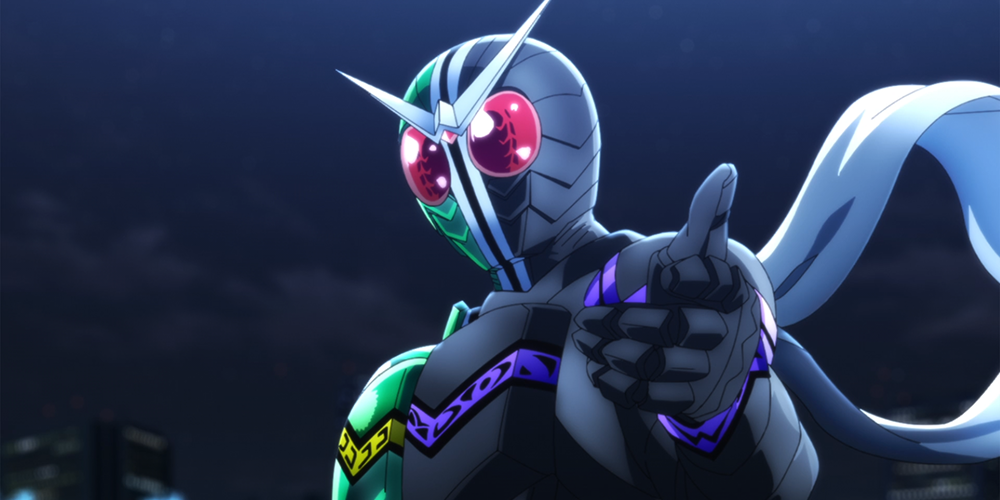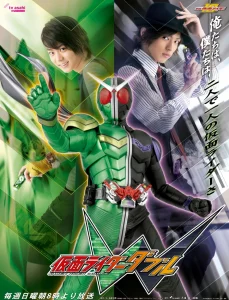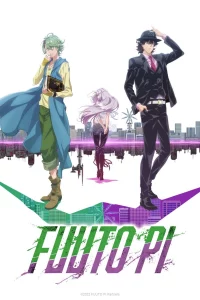
No Guest Found in this category
Now streaming on Crunchyroll, Fuuto PI is an anime adaptation of a manga sequel to a TV series, which is in itself a continuation of a show from the 1970s, so before we get into the main article, a little background on Kamen Rider will help everyone get up to speed.
What is Kamen Rider?
Kamen Rider was created by Shotaro Ishinomori in 1971, in which the protagonist Takeshi Hongo was captured and brainwashed by the evil organisation Shocker, and experimented on to become a cyborg to assist them in their plan for world domination. He broke free of his mind control and chose to use his newfound powers to bring down Shocker and fight to protect the world. The series lasted 98 episodes between ’71 and ’73, which was followed up by a new series introducing a new Rider to TV screens roughly every couple of years or so, until Kamen Rider Black RX in 1989 (which was used for Saban’s Masked Rider but we don’t talk about that). This marked the end of the ‘Showa Era’, with most fans marking it with the passing of Ishinomori in 1998.
Many of these shows had a very similar premise, in which a normal person is changed (physically, mentally, sometimes both) by some evil organisation, and uses that same change to fight for good instead of evil. If transforming heroes fighting monster bad guys sounds a lot like Power Rangers, you’d be correct, as Ishinomori was also responsible for the creation of Himitsu Sentai Gorenger, the predecessor for all Super Sentai shows (the source material for Power Rangers).
The Kamen Rider Revival
In the year 2000, the Kamen Rider series was revived for TV, with Kamen Rider Kuuga debuting to high ratings and huge success, revitalising the franchise and giving it a new direction. Where the ‘Showa Era’ Riders had an internal power source (having been changed into cyborgs, super-soldiers, etc), these new ‘Heisei Era’ Riders draw their powers from an external source, with Kuuga’s powers coming from an ancient artifact, and subsequent Riders drawing power from various different conveniently toy-shaped items and gadgets. However, the key premise of their powers being linked to the enemy has stayed consistent throughout. Yearly refreshes became the norm, with each series more-or-less disconnected from the one that came before, until the celebration series Kamen Rider Decade weaved the tale of a “passing through Kamen Rider”, that could travel between the worlds of the previous nine series and save them from destruction.
This brings us to the debut of the 11th ‘Heisei Era’ series, and the introduction of the two-in-one detective hero.
Kamen Rider W – The TV series

2009 Promotional Poster for Kamen Rider W
September 2009 saw the premiere of Kamen Rider W. Set in the fictional Windy City of Fuuto, W follows the story of the self-proclaimed hard-boiled detective Shotaro Hidari and his partner Philip, working alongside a unique cast of characters to investigate the black market sale of Gaia Memories and Dopant-related crime within the city.
If only a few of those words make sense that’s okay, here’s a quick rundown on how all this works. A Gaia Memory is a device that looks like a big chunky USB drive, which contains a specific power based on its name, such as Money, Virus, or T-Rex, with at least one for every letter of the alphabet. Using them turns regular people into monsters based around that power called Dopants, which is convenient when your series needs to have the protagonist fighting monsters on a weekly basis.
Utilising this same Gaia Memory technology for good, Shotaro and Philip transform into the two-in-one hero, Kamen Rider W, joined later on by the police officer and motorcycle-themed secondary hero, Terui Ryu/Kamen Rider Accel, to fight Dopants, put a stop to the Sonozaki Estate distributing them, and bring peace to the city of Fuuto. Mysteries unravel throughout the series, with many twists and turns as you would expect from a detective show, and not everything is as it seems on the surface. You can check out their first case below!
Fuuto Tantei – The Manga
In 2017, original series writer Riku Sanjo debuted the follow-up/sequel manga series Fuuto Tantei. Taking place approximately a year after the end of the TV series, the manga continues the adventures of Shotaro and Philip, solving various cases in Fuuto and squashing the last remnants of Gaia Memory-related incidents. The ongoing series has had 13 volumes released thus far in Japan, with each volume covering a single investigation, and collectively uncovering the wider mystery of a new character, Tokime, and her connection with the series antagonist, the Aurora Dopant.
In an interview earlier this year celebrating the launch of the Fuuto PI series, Sanjo said that the manga gave him the freedom to write about crimes you couldn’t necessarily show on TV, as well as not needing to consider budgetary or practical limitations when creating stories, scenarios and designs. The manga is also very much a labour of love for Kamen Rider W, with designer Katsuya Terada returning to design the new Dopants and Sanjo specifically interviewing artists who were fans of the show to come on board to illustrate. While the manga hasn’t been released in English as of yet, we can only hope the anime adaptation creates enough buzz that the powers that be can make it happen!
Fuuto PI – The Animation

Promotional Poster for the Fuuto PI Anime
This brings us to Fuuto PI, the latest chapter in W’s legacy and story, bringing the Fuuto Tantei manga to life, allowing for kinetic fight scenes, incredible transformation sequences, and creature/villain designs that, as Sanjo stated in the interview above, simply weren’t possible in the 2009 TV show. Each volume of the manga has been adapted and split into three episodes (so far), allowing the show to hit the beats of the three-act-structure of the classic detective novels and stories the original show was inspired by.
While it’s definitely a nostalgia trip to see these characters on-screen again after 10+ years, the show quickly brings new fans up to speed on the basics, then jumps straight into the mystery surrounding Tokime and the Aurora Dopant, as well as the wider threat to the Windy City. It’s a great show for fans to dip their toes into what all this Kamen Rider business is all about, without drowning them in a sea of references and call-backs to shows they haven’t seen. Also the ending theme to the show absolutely slaps (and is sung by Kamen Rider W alumni actors Mitsuru Matsuoka and Koji Kikkawa to boot!).
Airing Mondays on Crunchyroll, you can check out the trailer below!
Want More Kamen Rider?
If you just want to see more of the two-in-one detectives in (live-)action, Toei has recently unlocked the Kamen Rider W movie A to Z the Gaia Memories of Fate worldwide on their channel until the end of December, in which our trio of heroes square off against Kamen Rider Eternal and his team of NEVER mercenaries. It’s an hour of solid action, mystery, and showing off all the best aspects of the show.
Of course, we’ve spent most of this article talking about a show from 2009 and its ongoing legacy, but Kamen Rider has maintained a new fresh season every year since, and the Toei Tokusatsu World Channel has the first two episodes for every series available online. Whether you’re after heroes who are a novel-writing swordsman, dancing fruit samurai, high-school delinquent, or a literal wizard, there’s no end to the variety of heroes to check out!









